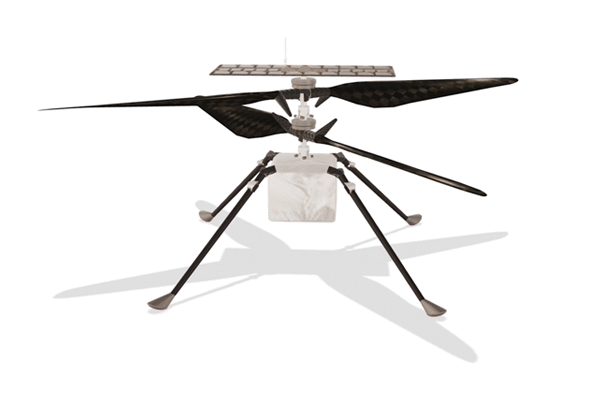NASA will soon attempt to fly the first aircraft on another planet! The Ingenuity rotocopter, which weighs only 4lbs, is designed to prove that we can perform powered flight on another planet – one with a very thin atmosphere that is just 1% the density of Earth’s. To do so, its four-foot, carbon-fibre blades will have to spin 8x faster on Mars than they would on Earth at around 2,400 revolutions per minute. Moving the blades this quickly requires a lot of power, as the rotocopter needs ~350 Watts of average power during flight. Energy will be harnessed by its solar panels and stored in lithium-ion batteries, enabling it to have enough juice for its flights.

Right now, the helicopter is kangaroo-Joey’d up in the belly of Percy the Rover, waiting to be placed on the surface of Mars. It’s currently stored horizontally, and will need to undergo a series of maneuvers to separate itself from the rover and be placed on the surface of Mars. Once on the surface, it’s up to its automated systems to take-off, fly, and land safely on its assigned flight path, since we can’t control it directly from Earth.
There are five projected flight tests to be completed within 30 Martian days (or sols) – each more complex than the last. The first will simply see if this sucker can take off by hovering 3m above the ground for 30 seconds for a Martian “Wright Bros” moment. And, even, if the rotocopter is able to take off in its first flight, its mission will be considered 90% successful, since this is considered a technical demonstration. The last flight is projected to cover an ambitious 980m of ground. Being able to cover this much ground using aircraft could really revolutionize our ability to survey in upcoming missions, and would likely pave the way for bigger and better aircraft to be developed.
Teams have tested Ingenuity in all the conditions they can create on Earth, as well as using those beloved mathematical models, so now it’s up to Ingenuity to see if it can pull it off. The NASA team anticipates performing the first flight test on April 19th, with flight data being received at 3:15am PT, but be sure to tune in for more details as they emerge by following @NASAPersevere.
Do you think Ingenuity can pull it off?




Comments
Pingback: Uranus is Shooting X-Rays (That's Right)